Stains are a huge nightmare for us, especially when it gets onto our favorite pieces of clothing. One can never be more careful whenever having a plate of spaghetti while wearing a white top. However when it comes to essential oils, how disastrous of a stain do they leave behind?
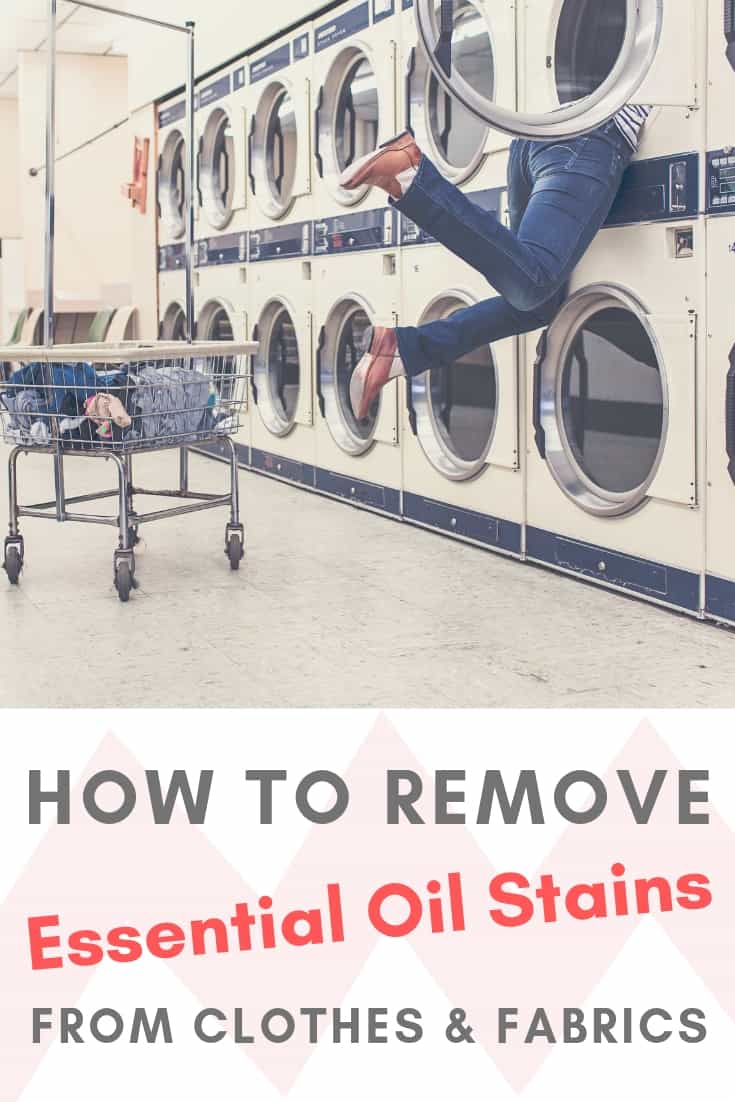 I will get to that very soon, but first let us understand what is the likelihood of us getting stains on our clothes from essential oils.
I will get to that very soon, but first let us understand what is the likelihood of us getting stains on our clothes from essential oils.
There are plenty of reasons why our clothes could come into contact with essential oils, be it accidental, and even on purpose.
Essential oils are highly concentrated and potent, but they are far from being a dangerous substance at all. We tend to use essential oils without really thinking much about the handling of it, and at times, a drop or two might come into contact with our favorite shirt or other piece of clothing.
At times, we might even intentionally apply essential oils on our clothes. Essential oils are a great alternative to commercially available perfumes when it comes to scenting ourselves up. Not only will it make you smell good, essential oils come with their own set of qualities that benefits us therapeutically.
Let’s understand what kind of potential damage essential oils can do to our clothes.
Can Essential Oils Stain Clothes?
 Essential oils, just like other oils, have the potential to stain your clothings and fabrics. The stains are usually obvious only when the oil was not diluted when it came into contact with your clothing. On our most common clothing fabric, the stain typically resembles an oil or grease patch you get from any other kind of oil, that looks like a discoloration or a darker patch. Although not the worst type of stain, these patches are often unsightly and obvious.
Essential oils, just like other oils, have the potential to stain your clothings and fabrics. The stains are usually obvious only when the oil was not diluted when it came into contact with your clothing. On our most common clothing fabric, the stain typically resembles an oil or grease patch you get from any other kind of oil, that looks like a discoloration or a darker patch. Although not the worst type of stain, these patches are often unsightly and obvious.
Certain fabrics, especially synthetics, react more to essential oils when come into contact. Instead of an oil patch, the affected area will have a change in appearance, or even in color. Unfortunately, if you encounter this, your fabric is very likely damaged beyond repair. Essential oils are known to deteriorate plastics. We should almost never let undiluted essential oils come into contact with plastics of any kind, including plastic bottles. Synthetic materials are also very likely to deteriorate upon contact of essential oils so be sure they are always separated from each other.
How to Get Rid of Essential Oil Stains from Clothes?
Stains are always much easier to remove whenever they are fresh. Make sure to take action as soon as possible.
The ways to remove essential oil stains are slightly different from your other common stains like from your wine or ketchup. Essential oils stains are immediately observable. It is a wet and darker shade from your clothing, resembling a water patch. However unlike water patches, oil patches do not dry off and disappear. The following steps should assist you in removing or greatly reduce its visibility of the stain.
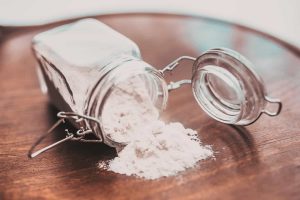 Apply talcum or baby powder onto the stain. You can also use flour or salt if they are more conveniently available around you. The powder acts as an absorbent, to draw out the excess oil that was soaked into the fibres, leaving behind a less concentrated patch to work on.
Apply talcum or baby powder onto the stain. You can also use flour or salt if they are more conveniently available around you. The powder acts as an absorbent, to draw out the excess oil that was soaked into the fibres, leaving behind a less concentrated patch to work on.- Use a small amount of laundry detergent or dish soap, and spot treat the area gently with a small brush or one of your toothbrush that you intend to replace. This step should effectively remove the stain in its entirety.
- If the spill was excessive, or was not treated immediately, you may then need to follow up with further treatment. Make sure to wash and rinse out the detergent or soap from the clothing article first, then dip the affected area into a bowl of white or distilled vinegar, and brush on the area gently. For extreme cases, soak the clothing overnight or for at least 6 hours, into the vinegar. Remember to rinse the vinegar out with water once you are done with this step.
- Launder the clothing article as usual. However, do not put it into the dryer once done, as the heat will set any remaining oil stain onto the fabric. Once it has air-dried, check to see if there are any remaining stains. If there are, repeat step 3 again, and only proceed back to your usual drying routine when you are certain that the oil stains are removed completely.
What if I Need a Stronger Solution?
Most of the popular essential oils we use are colorless, or only have a slight tinge to them. These oil stains are much easier to remove because they are easier to begin with. However, certain essential oils have a deep color to them. This photo shows an example of an essential oil stain with blood orange as an ingredient of the blend:

Blood Orange Essential Oil Stain
As we know, blood orange has a deep red color that contributes to the coloration of the essential oil. A highly effective solution to remove such stains is with 70% rubbing alcohol (isopropyl alcohol). You may use 90% rubbing alcohol or other concentrations you prefer, but 70% rubbing alcohol is already an effective concentration that is safe to come in contact with the skin in small amounts.
With a cotton ball, soak a generous amount of rubbing alcohol and gently pat on the stain. Do this for about a minute or two, and you should be able to see significant effects.
For bigger stains, you can add rubbing alcohol into a spray bottle and spray onto the stain until its saturated. Be sure to work in a well-ventilated space to minimize your exposure to the fumes of the rubbing alcohol. The rubbing alcohol should work its way into the fabric and remove the stain. Once you are satisfied with the results, rinse the clothing with water.
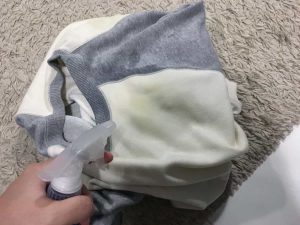
Saturate Stain with Rubbing Alcohol
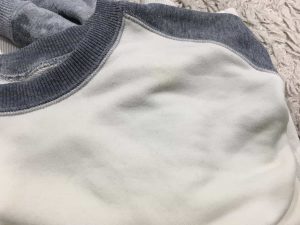
Quick and Amazing Results
How to Use Essential Oils on Clothes Without Staining Them?

One of the biggest reasons why we want to apply essential oils on our clothes is to make our clothes smell good and feel fresh.
Essential oils are a natural and healthier substitute for perfumes when it comes to fragrancing ourselves up. Many designer perfumes can be harsh and cloying, and we really want is to smell good and natural. This is to make ourselves feel comfortable, and to enjoy the therapeutic benefits of essential oils at the same time.
We can easily avoid essential oil stains to our clothes just by simply diluting the oils before application. Not only will application be much easier and uniform with a diluted spritz, we also minimize the risk of sensitization to essential oils from direct skin contact with undiluted oils.
How to Make Essential Oil Fabric Spray
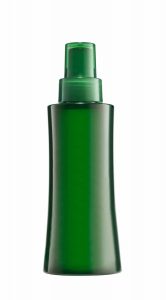
You will need:
– 3 ounces / 90 ml or larger spray bottle
– 2 ounces / 60 ml of distilled or purified water
– 0.5 ounces / 15 ml of vodka or witch hazel
– 10 drops of essential oil of your choice
The simple 3-step procedure:
Step 1: Start by adding 0.5 ounces / 15 ml of vodka or witch hazel into the spray bottle.
Step 2: Then add 10 drops of your favorite essential oil or blend into the spray bottle, cap it up and give it a gentle but thorough shake for half a minute. (The reason why we mix the essential oil to the vodka or witch hazel first is because the alcohol acts as a dispersant to keep the essential oil dispersed in water)
Step 3: Once done, add 2 ounces / 60 ml of distilled or purified water into the mixture, and give it another through shake for half a minute as well.
Remember to follow the steps accordingly so that your essential oils are well dispersed in the mixture.

